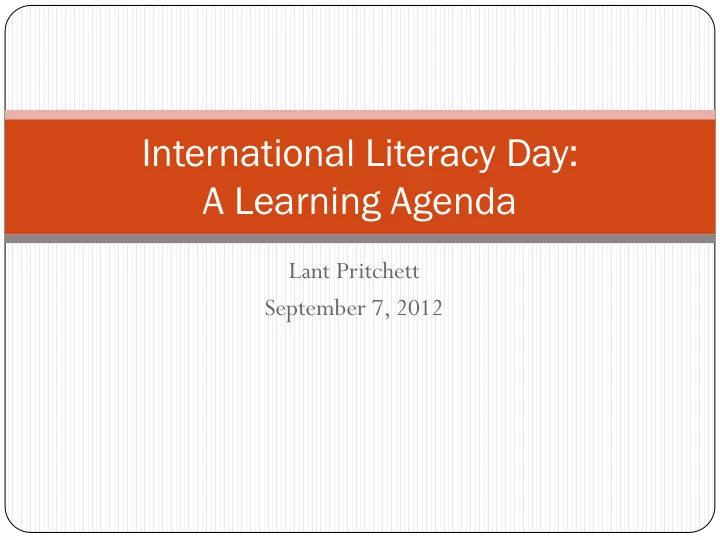

International Literacy Day: A Learning Agenda Lant Pritchett September 7, 2012
Four Main Points Learning profiles (learning per grade) are too low to lead to adequate comptency Extending school alone with not be enough An input based approach will not be enough to raise learning Beyond mimetic isomorphic mimicry to systems that focus on perfromance (Unless otherwise noted all graphs and data are from my forthcoming book “The Rebirth of Education” from Center for Global Development and draft chapters detailing the results are available online at http://www.hks.harvard.edu/fs/lpritch/)
Schooling should lead to opportunity but won’t if the learning profile is too shallow 1 0.9 Vertical Single 0.8 Digit with carry 0.7 9 (class level 1) 32 Percetn correct +8 0.6 +21 Vertical Double ---- Digit (class level 2) 0.5 695 0.4 Vertical addition, +505 0.3 triple digits (class level 4) 0.2 200+85+400=600+___ 0.1 0 Grade 2 Grade 3 Grade 4 Grade 5 Source: APRESt (via Pritchett 2012)
Little learning per year of schooling Country Average percentage point Of students who couldn’t increase in read or divide, percent who reading/division, learned in next grade per year of schooling Reading (grade 2 story) India 13.2 17.1 Pakistan 14.1 18.7 Tanzania 14.8 21.5 Uganda 7.7 8.2 (English) Kenya 20.4 34.1 Division (one digit into three digits) India 8.3 9.3 Pakistan 9.9 11.6 Uganda 11.3 14.4 Kenya 18.6 28.4
Length and measurement, illustrating conceptual understanding versus rote Class 4, 6, 8 Math Class 4: cm 5 cm ( 23.0% ) The length of the line in the figure above is 4 cm. 6 cm (46.0%) Only 7,2 percent Class 6: How long is the pencil shown in the picture? (Use the ruler shown in of students clear up the picture.) 5 cm ( 22.1% ) this fundamental 6 cm (41.7%) confusion in four years of schooling cm Class 8: 5 cm ( 34.7% ) . 6 cm (38.8%)
Shallow learning profiles lead to low cumulative performance of school leavers
If the learning profile is too flat just more schooling cannot reach learning goals Using the learning profile of Ghana in 2007 even reaching universal secondary completion only increases those above a minimal threshold by 10 percentage points
The impact of just more standard inputs is just not big enough—even doing everything desirable in “business as usual” fashion won’t be enough 1 0.9 Change in student standard deviation 0.8 Gains from the maximum feasible 0.7 expansion of all inputs at existing 0.6 effect sizes on learning are in the range 0.5 of .1 to .2 student standard deviations 0.4 0.3 0.2 0.1 0 Goal: One Jamaica Rajasthan, Orissa, India Sri Lanka Sri Lanka Sri Lanka SSD (excluding India (coeff) (coeff less std (coeff plus std anomaly) err) err) Study
Mimetic Isomorphic mimicry in snakes and schools: When is a school just a building? Camouflage of looking like a school—buildings, teachers, kids in uniform—allows public schools to Camouflage of looking like a survive without all the bother of educating children poisonous snake is a survival strategy—without the bother of being poisonous
Getting better outcomes is not just “speeding up” or getting more ambitious—covering too much too fast is part of the problem Moving ahead in the curriculum faster than children are learning leaves many children so far behind they learn little or nothing Source: Pritchett and Beatty 2012
There are things out there that work—but an educational eco- system that encourages demonstrated solutions to scale (and other to wither) is essential Fish swim …mammals swim …turtles swim …birds swim
Recommend
More recommend